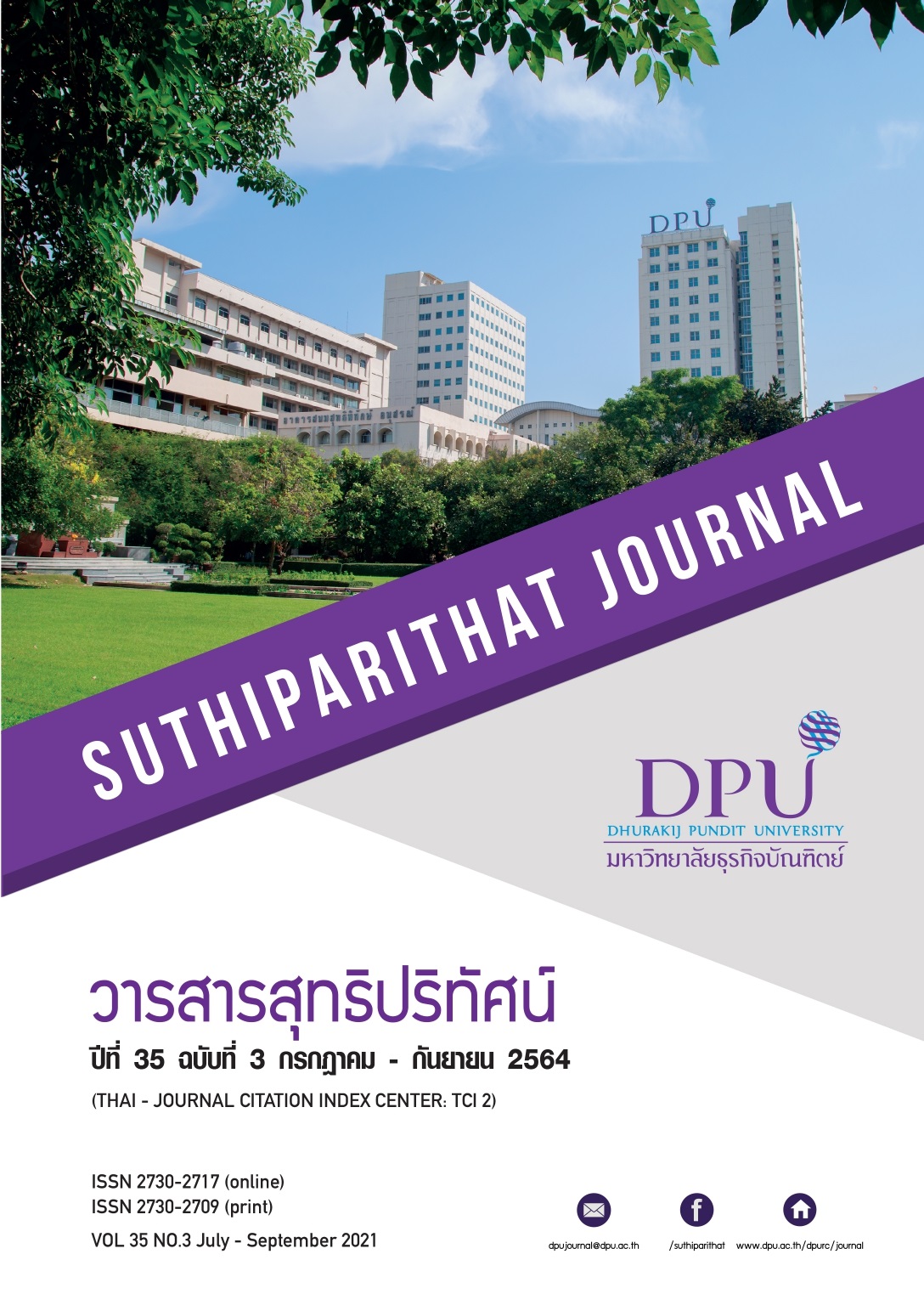การเป็นผู้ประกอบการในยุคเศรษฐกิจดิจิทัล
คำสำคัญ:
การเป็นผู้ประกอบการ, เศรษฐกิจดิจิทัล, ความสามารถทางนวัตกรรม, การทำงานเชิงรุก, การเผชิญความกล้าเสี่ยงบทคัดย่อ
บทความนี้มีจุดประสงค์เพื่อนำเสนอความรู้และให้ข้อเสนอแนะความเป็นผู้ประกอบการไทยในยุคเศรษฐกิจดิจิทัล จากการทบทวนวรรณกรรม พบว่า ผลลัพธ์ของการเป็นผู้ประกอบการเชิงบูรณาการมีอยู่ 2 ทาง คือ (1) ควรมีปัจจัยนำเข้าซึ่งสามารถส่งผ่านกระบวนการประกอบการภายในไปสู่ผลผลลัพธ์ (2) คุณลักษณะของการเป็นผู้ประกอบการ ได้แก่ ความสามารถทางนวัตกรรม การกล้าเผชิญความเสี่ยง และการทำงานเชิงรุก ทั้งนี้ คุณลักษณะความเป็นผู้ประกอบการดูเหมือนจะเหมาะสมกับความเป็นผู้ประกอบการในยุคเศรษฐกิจดิจิทัลมากที่สุดในความพยายามที่จะต้องสร้างคุณค่าให้แก่สินค้าและ/หรือบริการอย่างมีนวัตกรรม เพื่อตอบสนองความต้องการของลูกค้าได้อย่างถูกต้อง โดยที่การกล้าเผชิญความเสี่ยงมีความสำคัญตรงที่จะสนับสนุนให้ผู้ประกอบการประสบความสำเร็จในการทำธุรกิจ ขณะที่การทำงานเชิงรุกผู้บริหารต้องพัฒนาให้เกิดขึ้นในตัวพนักงาน เพื่อให้สามารถเล็งเห็นวิกฤตและเปลี่ยนวิกฤตให้เป็นโอกาส ซึ่งผลลัพธ์ที่ได้จะเป็นประโยชน์ต่อการนำเสนอสินค้าและบริการที่มีคุณค่าหลักต่อลูกค้าได้อย่างถูกต้องและเกิดความพึงพอใจสูงสุด จึงมองเป็นโอกาสและความท้าทายของผู้ประกอบการไทยที่มีศักยภาพในการขยายธุรกิจเข้าสู่ตลาดโลก
เอกสารอ้างอิง
จุไรวรรณ รินทพล และวิชิต อู่อ้น. (2562). การตัดสินใจเชิงกลยุทธ์ด้านการลงทุนของนักลงทุนในตลาดหลักทรัพย์แห่งประเทศไทย. วารสารศรีปทุมปริทัศน์ ฉบับมนุษยศาสตร์และสังคมศาสตร์, 19(2), 49-62. https://so05.tci-thaijo.org/index.php/spurhs/article/view/204391/155097
วรมรรณ นามวงศ์, ประภัสสร วรรณสถิต, กัญญ์พัสวี กล่อมธงเจริญ, และชัยวัฒน์ ใบไม้. (2562). คุณลักษณะการเป็นผู้ประกอบการของเจ้าของธุรกิจค้าปลีกที่เข้าร่วมโครงการธงฟ้าประชารัฐ กรณีศึกษา: พื้นที่ภาคเหนือตอนบนของประเทศไทย. วารสารบริหารธุรกิจ มหาวิทยาลัยแม่โจ้, 1(1), 48-59. http://www.bareview.mju.ac.th/journal1/doc_5.pdf
สำนักงานพัฒนาธุรกรรมทางอิเล็กทรอนิกส์. (2563). ดิจิทัลอีโคโนมี. สืบค้น 28 มกราคม 2563, จาก https://www.etda.or.th/digital-economy.html
สำนักงานนวัตกรรมแห่งชาต. (2552). Innovation management in the economic era Driven by knowledge. สืบค้น 28 มกราคม 2563, จาก from http://www.nia.or.th/innolinks
กระทรวงอุตสาหกรรม. (2563). Digital economy, new economic drive policy. สืบค้น 28 มกราคม 2563, จาก http://www.industry.go.th/index.php/th/knowledge/item/39461-2017-05-03-02-44-35
Antoncic, B., & Hisrich, R. D. H. (2003). Clarifying the intrapreneurship concept. Journal of Small Business and Enterprise Development, 10(1), 7–24. https://doi.org/10.1108/14626000310461187
Astuty, Eriana, Rahayu, Agus, Disman, & Wibowo, Lili Adi. (2018). Breakthrough in Indonesian creative industry through soft innovation. International Journal of Entrepreneurship, 22(2), 1-10.
Barney, J. B. (1991). Firm resources and sustained competitive advantage. Journal of Management, 17(1), 99-120.
Baron, R. A., & Shane, S. A. (2008). Entrepreneurship: A process perspective (2nd ed.). South-Western: Thomson.
Campos H. M., de la Parra, J. P. N., & Parellada, F. S. (2012). The entrepreneurial orientation-dominant logic-performance relationship in new ventures: An exploratory quantitative study. Brazilian Administration Review, 4, 60-77. Retrieved from http://www.anpad.org.br/bar
Covin, J. G., & Slevin, D. P. (1991). A Conceptual Model of Entrepreneurship as Firm Behavior. Entrepreneurship Theory and Practice, 16(1), 7–26. https://doi.org/10.1177/104225879101600102
Dess, G., Lumpkin, G. T., & Taylor, M. L. (2005). Strategic management: Creating competitive advantage (2nd ed.). New York: McGraw-Hill.
Drucker, P. F. (1985). Innovation and entrepreneurship: practice and principles. Harper Business.
du Plessis, M. (2007). The role of knowledge management in innovation. Journal of Knowledge Management, 11(4), 20-29. https://doi.org/10.1108/13673270710762684
Entrialgo, M. (2002). The impact of the alignment of strategy and managerial characteristic on Spanish SMEs. Journal of Small Business Management, 40(3), 260-270. doi:10.1111/1540-627X.00056
Frederick, H. H., Kuratko, D. F., & Hodgetts, R. M. (2007). Entrepreneurship: Theory process practice (Asia-Pacific ed.). Thomson South-Western.
Gartner, W. B. (1990). What are we talking about when we talk about entrepreneurship?. Journal of Business Venturing, 5(1), 15-28. doi:10.1016/0883-9026(90)90023-M
Garvin, D. A., & Levesque, L. C. (2006). A note on scenario planning. Harvard Business School.
Kietsarapipop, A. (2015). Digital economy, new economic drive policy. Retrieved January 27, 2020, from https://library2.parliament.go.th/ejournal/content_af/2558/mar2558-2.pdf (in Thai)
Korra, E., Giotopoulos, I., & Tsakanikas, A. (2018). CSR Practices and SME innovativeness in Greece. Entrepreneurship and the Sustainable Development Goals, 8, 119-132. https://doi.org/10.1108/S2040-724620180000008012
Kuratko, D., Morris, M., & Schindehutte, M. (2015). Understanding the dynamics of entrepreneurship through framework approaches. Small Business Economics, 45(1), 1-13.. https://doi.org/10.1007/s11187-015-9627-3
Luecke, R., & Katz, R. (2003). Managing creativity and innovation. Boston: Harvard Business School Press.
Lumpkin, G. T., & Dess, G. G. (1996). Clarifying the entrepreneurial orientation construct and linking It to performance. Academy of Management Review, 21(1), 135-172. https://doi.org/10.2307/258632
Lumpkin, G. T., & Dess, G. G. (2001). Linking two dimensions of entrepreneurial orientation to firm performance: The moderating role of environment and industry life cycle. Journal of Business Venturing, 16(5), 429-451. https://doi.org/10.1016/S0883-9026(00)00048-3
Marion, D. (2006). The antecedent and consequences of a strategic orientation that leads to organizational structure, performance, and competitive advantage in manufacturing. Management and Engineering of the University of Toledo.
Morris, M. H., & Lewis, P. S. (1995). The determinants of entrepreneurial activity. European Journal of Marketing, 29(7), 31-48. doi:10.1108/03090569510094991
Morris, M. H., Kuratko, D. F., & Covin, J. G. (2008). Corporate entrepreneurship and innovation. Mason, Ohio: Thomson South-Western.
Rauch, A., Wiklund, J., Lumpkin, G. T., & Frese, M. (2009). Entrepreneurial orientation and business performance: An assessment of past research and suggestions for the future. Entrepreneurship Theory & Practice, 33(3), 761-787. https://doi.org/10.1111/j.1540-6520.2009.00308.x
Shepherd, D. (2014). Entrepreneurship and competitive strategy: An integrative approach. The Journal of Entrepreneurship, 23(1), 115-135.
Stam, F.C., & Spigel, B. (2016). Entrepreneurial ecosystems. U.S.E. Discussion paper series, 16(13), 1-15. doi:10.4135/9781473984080.n21
Teepapal, P., & Teepapal, T. (2009). Entrepreneurship. Bangkok: Amorn Publish.
Timmons, A. J. (1989). The entrepreneurial mind. Brick House Publish.
Vaillant, Y., & Lafuente, E. (2018). Entrepreneurial experience and the innovativeness of serial entrepreneurs. Management Decision, 57(11), 2869-2889.
Venkatraman, N. (1989). Strategic orientation of business enterprises: The construct, dimensionality, and measurement. Management Science, 35(8), 942-962. https://www.jstor.org/stable/2632149
Weerawardena, J., & Coote, L. (2001). An empirical investigation into entrepreneurship and organizational innovation-based competitive strategy. Journal of Research in Marketing & Entrepreneurship, 3(1), 51-70. https://doi.org/10.1108/14715200180001477
Zhan, J. (2006). Develop of theory on entrepreneurial orientation: Empirical evidence from Hebei, China and Flanders, Belgium [Doctoral dissertation]. Belgium: Ghent University.
ดาวน์โหลด
เผยแพร่แล้ว
รูปแบบการอ้างอิง
ฉบับ
ประเภทบทความ
สัญญาอนุญาต
เนื้อหาและข้อมูลในบทความที่ลงตีพิมพ์ในวารสารสุทธิปริทัศน์ ถือเป็นข้อคิดเห็นและความรับผิดชอบของผู้เขียนบทความโดยตรงซึ่งกองบรรณาธิการวารสาร ไม่จำเป็นต้องเห็นด้วย หรือร่วมรับผิดชอบใด ๆ
บทความ ข้อมูล เนื้อหา รูปภาพ ฯลฯ ที่ได้รับการตีพิมพ์ในวารสารสุทธิปริทัศน์ ถือเป็นลิขสิทธิ์ของวารสารสุทธิปริทัศน์หากบุคคลหรือหน่วยงานใดต้องการนำทั้งหมดหรือส่วนหนึ่งส่วนใดไปเผยแพร่ต่อหรือเพื่อกระทำการใด ๆ จะต้องได้รับอนุญาตเป็นลายลักษณ์อักษรจากวารสารสุทธิปริทัศน์ก่อนเท่านั้น







